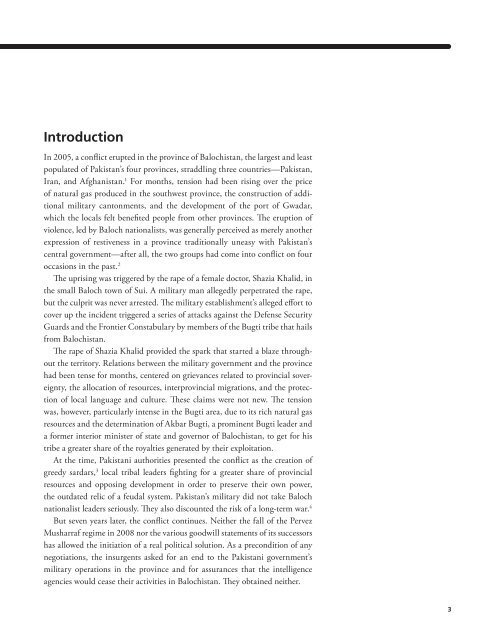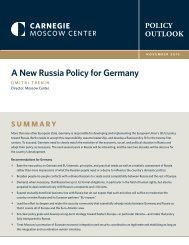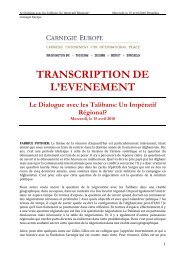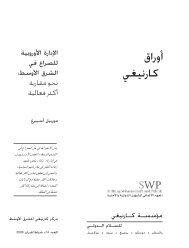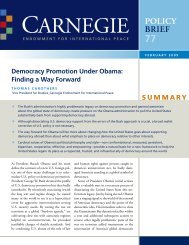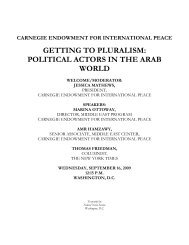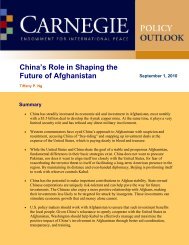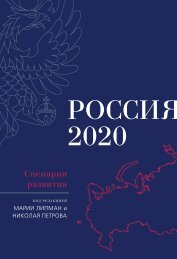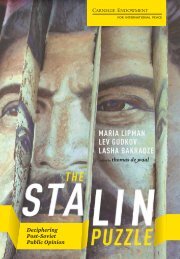BALOCHISTAN - Carnegie Endowment for International Peace
BALOCHISTAN - Carnegie Endowment for International Peace
BALOCHISTAN - Carnegie Endowment for International Peace
You also want an ePaper? Increase the reach of your titles
YUMPU automatically turns print PDFs into web optimized ePapers that Google loves.
Introduction<br />
In 2005, a conflict erupted in the province of Balochistan, the largest and least<br />
populated of Pakistan’s four provinces, straddling three countries—Pakistan,<br />
Iran, and Afghanistan. 1 For months, tension had been rising over the price<br />
of natural gas produced in the southwest province, the construction of additional<br />
military cantonments, and the development of the port of Gwadar,<br />
which the locals felt benefited people from other provinces. The eruption of<br />
violence, led by Baloch nationalists, was generally perceived as merely another<br />
expression of restiveness in a province traditionally uneasy with Pakistan’s<br />
central government—after all, the two groups had come into conflict on four<br />
occasions in the past. 2<br />
The uprising was triggered by the rape of a female doctor, Shazia Khalid, in<br />
the small Baloch town of Sui. A military man allegedly perpetrated the rape,<br />
but the culprit was never arrested. The military establishment’s alleged ef<strong>for</strong>t to<br />
cover up the incident triggered a series of attacks against the Defense Security<br />
Guards and the Frontier Constabulary by members of the Bugti tribe that hails<br />
from Balochistan.<br />
The rape of Shazia Khalid provided the spark that started a blaze throughout<br />
the territory. Relations between the military government and the province<br />
had been tense <strong>for</strong> months, centered on grievances related to provincial sovereignty,<br />
the allocation of resources, interprovincial migrations, and the protection<br />
of local language and culture. These claims were not new. The tension<br />
was, however, particularly intense in the Bugti area, due to its rich natural gas<br />
resources and the determination of Akbar Bugti, a prominent Bugti leader and<br />
a <strong>for</strong>mer interior minister of state and governor of Balochistan, to get <strong>for</strong> his<br />
tribe a greater share of the royalties generated by their exploitation.<br />
At the time, Pakistani authorities presented the conflict as the creation of<br />
greedy sardars, 3 local tribal leaders fighting <strong>for</strong> a greater share of provincial<br />
resources and opposing development in order to preserve their own power,<br />
the outdated relic of a feudal system. Pakistan’s military did not take Baloch<br />
nationalist leaders seriously. They also discounted the risk of a long-term war. 4<br />
But seven years later, the conflict continues. Neither the fall of the Pervez<br />
Musharraf regime in 2008 nor the various goodwill statements of its successors<br />
has allowed the initiation of a real political solution. As a precondition of any<br />
negotiations, the insurgents asked <strong>for</strong> an end to the Pakistani government’s<br />
military operations in the province and <strong>for</strong> assurances that the intelligence<br />
agencies would cease their activities in Balochistan. They obtained neither.<br />
3


